Bulletin: RollerTrol™ Automation Systems is Launched!
- We have been busy making and selling roller blinds and projector screens for some time, and we have decided to start selling the components at
RollerTrol.com so others can do the same.
- Take a look at our online store for tubular motors and other associated products - make your own custom shade or screen size
that fits your room perfectly! We also have special motor kits that work with x10 automation systems.
- While you're at it, check out our tubular motors with built-in radio controllers. When used with our multi-channel remotes, you can control the screen AND blackout blinds with a single remote!
End Bulletin: RollerTrol™ Automation Systems
Well, it's taken a
while, but I finally made my decision on my first home theater
screen. It was a difficult choice that has taken months of research,
with many issues to resolve.
I had a number of reasons to choose the BenQ front projection DLP
'digital light cannon' as my best buy (although the SVGA BenQ PB6100 was
another good choice). Here is a summary of the features I wanted:
-a BIG screen for my money, not just something a foot or two
bigger than my 27" TV
-something unobtrusive that wouldn't dominate the room when not in use
-a bright, sharp, high contrast picture without screen door effect (SDE)
-something with a cost that didn't require a second mortgage
-a display that didn't deteriorate significantly over time
-a watchable picture in ambient lighting conditions
-a reasonably wide viewing angle
-XGA (1024x768) resolution
-RGB computer input
I also decided that I wanted to run my theater system from a computer, removing
as much video processing as possible from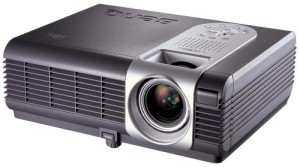 the internal projector electronics. This allowed me to buy a projector that had most
of it's development costs focused on the light projection technology
itself. It also gives me much more flexibility and a significant picture
quality improvement if I run my own external
hardware and software on a PC to maximize the picture resolution, and to deploy
enhancements as they become available, thereby lessening the obsolescence
factor. It is possible to get better results from a dedicated PC, since
the processing power is considerably greater than anything a
manufacturer can hope to include in the cost of projector production. This type of use for computers
has created a whole new field, often referred to as HTPC (Home
Theater Personal Computer). I'm looking forward to
playing with some of the advanced software such as WinDVD Platinum.
the internal projector electronics. This allowed me to buy a projector that had most
of it's development costs focused on the light projection technology
itself. It also gives me much more flexibility and a significant picture
quality improvement if I run my own external
hardware and software on a PC to maximize the picture resolution, and to deploy
enhancements as they become available, thereby lessening the obsolescence
factor. It is possible to get better results from a dedicated PC, since
the processing power is considerably greater than anything a
manufacturer can hope to include in the cost of projector production. This type of use for computers
has created a whole new field, often referred to as HTPC (Home
Theater Personal Computer). I'm looking forward to
playing with some of the advanced software such as WinDVD Platinum.
The most economical way to get a big screen that disappears when not in
use, is to use a front projector - hence my decision to purchase the
BenQ PB 6200 DLP front projector. I chose the DLP technology over LCD
and LCoS because of issues concerning brightness, contrast, longevity
and initial investment.
I picked it up online for around $1700, which included a spare lamp bulb (a $400 value). The spare
bulb bundle offer ends at the end of April, but even without it, this
projector is an excellent value - you won't find a better buy anywhere.
I see that the price has dropped considerably since I bought it.
My projector was shipped the day after I placed the order - pretty good,
I thought, especially considering the high demand for this unit!
Here is a brief summary of the BenQ PB6200 specs:
-native resolution: XGA (1024 x 768 pixels)
-aspect ratio: 4:3 Native/16:9 Selectable
-light output: 1700 lumens
-contrast ratio: full on/full off 2000:1
-reflective display technology: 12° DLP Digital Light Processor
(DDR Double Data Rate .7" DMD
Digital Micromirror Device)
-HDTV-compatible (480p, 720p, and 1080i)
-4 segment color wheel, 3X speed
-Picture In Picture (PIP)
-inputs: RGB, component, composite, S video
-lamp life: 3,000 hours in eco mode
-3 year, first year swap replacement warranty
-full function remote control
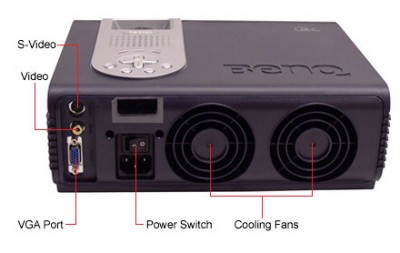
For around $30, I picked up a 10 foot diagonal bright white roll-up screen
(gain of about 1.2) that will cover the end
wall in my great room. You can find rolled projector screen material on
Ebay. I may also convert it to a
motorized, remote controlled, retractable unit, using X10 switch modules
and a motorized drapery controller to raise and lower the screen (for more info on the
incredibly useful x10 technology, see our home page).
I bought a
chain driven blind fixture from a local hardware store, cut off the
vinyl blind, hacksawed the horizontal aluminum roller tube in half, and
inserted an 8 ft.
piece of anodized aluminum tubing to extend the roller, for a total
screen width of 110". The projector will
be concealed in a light fixture array hung from the ceiling, so that the
whole system will be quite unobtrusive when not being used. Here are
some pictures of the drop down screen partially unfurled (left) and fully
retracted (right):
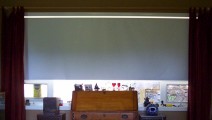
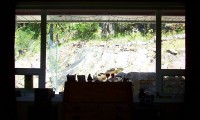
Now you see it
...
Now you don't ...
I'll use the DVD in my laptop as a
video source for now, as I examine some of the amazing software
available for enhanced home theater use. Once I have experimented with
the output from my laptop and decided on my processing needs, I'll
probably buy an
inexpensive re-certified off-lease laptop and use it as a dedicated HTPC. The HTPC experience will be the
basis for another forthcoming article, and between now and then I'll
figure out if I really need to buy a regular desktop case PC instead.
Here's the official BenQ product announcement for the PB 6200:
City of Industry, CA (Feb. 24, 2004) - BenQ, a leading
manufacturer of DLP™ based digital projectors, introduced its latest
digital projector with the PB6200. The PB6200 is a sturdy, yet
lightweight digital projector that is ideal for a variety of
professional and personal home theater applications and installations.
The PB6200 utilizes proprietary BenQ video-processing technology to
support the latest DLP chipset from Texas Instruments. The new DLP DDR
chipsets produce flawless pictures that won't fade or degrade over time,
and the optical engine lifetime exceeds 100,000* hours while maintaining
the images' original clarity.
"The BenQ PB6200 is an ideal projector for those wanting a powerful
and compact projector with XGA resolution capacity," said Jeff
Chen, vice president of Digital Media at BenQ America. "The PB6200
delivers the functionality and the performance of an XGA projector, but
at a competitive price point. As visual presentations become more
sophisticated, the need for an XGA projector becomes greater. The PB6200
offers the features to match the latest software programs, presentation
ideas and videos."
The BenQ PB6200
The BenQ PB6200 is an XGA digital projector with a high 2000:1 contrast
ratio at 1,700 ANSI lumens. It has a native resolution of 1024 x 768,
and can support resolutions from 640 x 350 up to 1280 x 1024 and 4:3 or
16:9 aspect ratios. The PB6200 has a throw ratio of 60-inches at
6.6-feet and delivers images from 40- to 300-inches. It is compatible
with NTSC, PAL, SECAM and NTSC 4.43 video systems, and is
HDTV-compatible (480p, 720p and 1080i) with direct YPbPr/component
(through VGA port), S-Video and composite video inputs.
The PB6200 integrates BenQ's proprietary Dynamic Color Management System
(DCMS) technology and supports 16.7 million color palettes, as well as
four-segment color wheels to ensure accurate color reproduction. It
features PIP functions and a Digital Keystone correction system for
quick and easy set-up. The PB6200 delivers a lamp life of up to 2,000
hours, which can also last up to 3,000 hours under "economy"
mode.
All BenQ digital projectors come with the company's product commitment-a
free first year "Xpress Xchange" program and a three-year
limited warranty.
The BenQ PB6200 has a manufacturer's suggested retail price of $1,795
through BenQ's distribution channels.
Was this projector purchase a compromise decision? You bet! There are a
number of features and performance levels that I gave up, in favor of this particular
price/performance ratio ...
Perhaps the most significant missing feature is the DVI
digital input
on this unit; only analog RGB, component, composite, and S video inputs
are present. This
may sound like a major item, but it's important to remember that digital
HDTV
sources are not widely available yet. In anticipation of this screen
purchase, I recently bought from my so called 'digital cable'
service a Motorola 2500 cable converter. It doesn't
have a digital output. I later discovered that I could pay them an extra per-channel monthly fee
for each of the few local HDTV broadcast channels, but I'd also have to
buy another expensive digital output converter from them, just so I can watch
commercials in high resolution. Thanks, but no thanks!
Our main usage is watching film laid on DVD, and it's important to understand
that the current DVD format is not HDTV. It is a relatively high
resolution digital format (DTV), but the
HDTV higher definition encoding will only appear in the next generation of DVD
players. By the time that happens, I'll be ready for a screen upgrade
anyway, and I will get digital inputs at that time. The current DVD format
is digital, so I will be putting up with the slight degradation
introduced by the digital-to-analog conversion RGB output on the VGA
monitor connector of my HTPC
(and the subsequent analog-to-digital re-conversion inside the the
projector). Nevertheless, this picture is still very sharp, with
excellent color saturation, and I plan to introduce numerous software
image enhancements via my laptop, such as 'high end' de-interlacing and
scaling. Keep in mind that it is a big advantage to process the video
within the digital realm, as it comes off the DVD player inside the
HTPC, before it is finally converted to analog at the output and sent to
the projector.
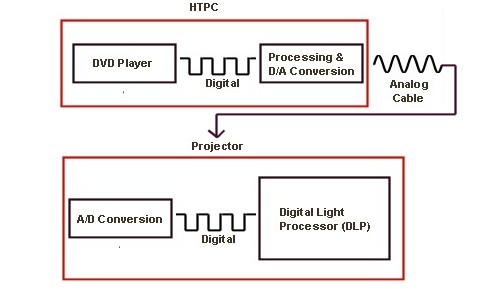
All things considered, this really wasn't too much of a sacrifice,
considering the cost. Yes, there are other projectors out there that
have DVI digital inputs and the excellent Faroudja de-interlacing scan
doubler, but they are typically twice the price
and more, with equivalent specs. I also like the idea of keeping the processing external, so
that I can upgrade the picture as the software improves. This unit does
have internal processing, but I'll be bypassing it in favor of the more
powerful systems I can deploy in my laptop, such as WinDVD Platinum.
My feeling about HDTV is that it is NQTY (Not Quite
There Yet) and when it finally becomes the norm, keeping
the video signal entirely within the digital realm will be much more
important. Also, for those of you using a stand-alone DVD player
instead of an HTPC, keep in mind that very few of these units are
produced with a digital output at this time, so purchasing a display
with a DVI digital input may not make much sense unless you were
planning to keep it for a long time (anticipating future use). Also keep
in mind that a digital image isn't necessarily better than an analog
image - in some cases it can be worse. An HDTV picture can also be
analog; Japanese HDTV is broadcast using an analog signal.
If you decide to purchase a unit with a DVI digital input, you may also
want to check to see if it supports the HDCP copy protection protocol,
and which flavor, as there is a standards war going on at the moment (you
could end up with a DVI input that is obsolete).
If it doesn't, you could end up with a reduction in quality on copy
protected material. The copy protection and standards incompatibility problems
can be avoided entirely by using an HTPC as your
video source.
I also compromised somewhat in the area of brightness vs contrast. I
wanted a high contrast unit, for sure, but I also wanted to be able to
watch a movie without putting up blackout curtains in our great room.
The 2000:1 contrast of the PB 6200 is quite high, and although other
projectors are reaching into the 3000:1 realm with this DMD chipset,
they do this by stopping down the projector iris, thus lowering the
brightness in favor of contrast (they are still only typically running
at 2000:1 with the iris fully open). The 1700 lumens rating of this unit
is quite high, and should work well in a partially lit environment.
A further compromise consideration was the speed of the spinning color
wheel in single chip DLP projectors (used to create the 3 primary
colors: red, blue, green).
Most of the lower priced units use a 2x speed, whereas this BenQ unit
has a 3x wheel. This should reduce or eliminate the so called 'rainbow
effect' motion artifacts attributed to this type of projector (also
considering the DDR [Double Data Rate] of
this latest DLP chip), although the more expensive units are running at
5x and 6x speeds. I wasn't particularly bothered even by 2x color discs,
but
some people are more sensitive to this anomaly than others, so you
should always look at a DLP projector (front or rear projection) before
you buy, to determine your tolerance level. Buying a 3 chip DLP
projector would
also be an option (eliminating the color wheel altogether), at about 5
times the price.
I could have made a further compromise in the area of resolution by
purchasing an SVGA projector (800x600 pixels), but I run my computers at
XGA (1024x768) and I didn't see the logic in that, since I'm using the
DVD in my computer as the primary video source.
I also chose a native 4:3 aspect ratio, even though I'll be watching a
lot of 16:9 sources. I found that these projectors were less expensive,
and actually displayed the same vertical resolution at 16:9 as the the new
'Mustang' DMD chip that runs in native 16:9. It also has the benefit of
displaying 4:3 sources at a larger size and/or higher resolution.
My next articles will cover more about the projector setup, video and
sound processing, and what can be done on an HTPC to
enhance the picture and sound quality. (Author's note May 6/04:
The projector arrived yesterday; preliminary results were outstanding,
see the NEXT
ARTICLE about setting it up).
For the sake of clarity, here are some acronym and terminology definitions relating to
the various display technologies, used in the other table below to compare the
various screen types:
| TERM |
DEFINITION |
| TLA |
Three Letter
Acronym |
| HDTV |
High Definition
Television. The highest quality video picture
available in Digital TV. In the U.S., the 1080i and 720p
resolution formats in a 16:9 aspect ratio are the two acceptable
HDTV formats. Regular NTSC analog TV is 480i. |
| HTPC |
Home Theater
Personal Computer. The use of a PC as a processing
and source control platform for a home theater system. |
| RPTV |
Rear Projection
TV. The type of home theater screen system where the image
is projected onto the back of the screen. Can be DLP, LCD, CRT
projection technology. |
| Lumens |
An ANSI Lumen is
a measurement of light radiation or brightness. A 3,000 Lumen
projector creates a brighter picture than a 2,000 Lumen unit. The ANSI
prefix is a standards designation (American National
Standards Institute). |
| Nits |
Plasma and LCD
manufacturers use this term to define the brightness of their
screens. Another term for Nits is Candelas per square meter (Cd/m2).
One nit = 0.2919 foot-lambert. Nits includes an area definition,
unlike lumens, so you can't simply divide by Watts to establish a
Nits/watt spec. |
| 480i 720p
1080p |
resolution
measurement in lines, p for "progressive
scan", i for "interlaced scan".
Conventional TV (e.g. 480i) is interlaced whereby the screen is
scanned twice by alternate lines that are interleaved
(interlaced), whereas HDTV (e.g. 720p) can scan all lines
sequentially (consecutively or progressively). |
| DVI HDCP |
Digital Visual
Interface technology with High-bandwidth Digital
Content Protection. Developed by Intel Corporation,
HDCP is a specification to protect digital entertainment content
through the DVI interface. The HDCP specification provides a
transparent method for transmitting and receiving digital
entertainment content to DVI-compliant digital displays. Some
products, such as set-top boxes and DVD burners will require this
connector. Even if you have a HDTV set-top box, if it lacks the
DVI, your signal may be degraded. |
| HDMI |
High Definition
Multimedia Interface. Like DVI, HDMI is another
digital interface, and from what we saw at CES 2005, it may become
the universal standard. Developed by Sony, Hitachi, Thomson (RCA),
Philips, Matsushita (Panasonic), Toshiba and Silicon Image, the
High-Definition Multimedia Interface (HDMI) has emerged as the
connection standard for HDTV and the consumer electronics market.
HDMI is the first digital interface to combine uncompressed
high-definition video, multi-channel audio and intelligent format
and command data in a single digital interface. |
| SACD |
Super Audio
CD uses a new recording technology called Direct Stream
Digital. DSD records a one bit digital signal at a
sample rate of 2.8 million times per second, 64 times higher than
conventional CD's.
|
| NTSC |
Existing color
TV standard developed in the U.S. in 1953 by the National Television
System Committee. NTSC vertical line resolution is
525 lines/frame and the vertical frequency is 60Hz. The NTSC frame
rate is 29.97 frames/sec.
|
| CRT |
Cathode Ray
Tube - venerable old style picture tube |
| PDP |
Plasma Display
Panel, plasma is a physics term for an electrically charged
gas |
| LCD |
Liquid Crystal
Display, same as laptop screens |
| TFT |
Thin Film
Technology, a type of LCD |
| DLP |
Digital Light
Processor, a reflective light switch chip developed by TI.
Has a very fast response time - no motion lag |
| TI |
Texas Instruments
Corp., original manufacturer of DMD's and DLP's |
| DMD |
Digital Micro-mirror
Device - chip for DLP technology by TI |
| DNIe |
Digital Natural
Image enhancement - chip for optimizing video
picture quality, by Samsung (used in their DLP units) |
| LCoS |
Liquid Crystal
on Silicon, reflective light switch |
| SXRD
projection |
Silicon X-tal Reflective Display:
Sony's incarnation of LCoS technology. Sharp picture, no pixelation, very high resolution, reflective
system won't burn out picture element, "no moving parts"
design usually incorporates 3 imaging chips for primary colors,
instead of color wheel. |
| SED |
Surface conduction
Electron emitter Display by Toshiba/Canon |
| FED |
Field Emission
Display: New technology from Sony |
| OLED |
Organic Light
Emitting Diode display: new technology from Seiko-Epson |
| D-iLA |
Direct
Drive Image Light Amplifier, LCoS chip
developed by JVC |
| QXGA |
high screen
resolution of 2048 x 1536, attained by D-iLA chip |
| DCDi |
Directional
Correlation Deinterlacing (a de-interlacing
method to eliminate jagged edges (jaggies) along diagonal lines
caused by interpolation, developed by Faroudja corp. An
important feature to look for, this Emmy® award
winning technology was once only available in products costing
$20,000 or more, and is now available in numerous products costing
well below $2,000 |
| aspect ratio |
ratio of screen
width to height. An aspect ratio of 4:3 is conventional TV and
16:9 is HDTV (and film) |
| 3-2 pulldown |
a method of
film-to-video conversion |
| twitter and
judder |
terms describing
film conversion related artifacts |
| anamorphic
lens |
a special lens
that compresses the pixels of a 4:3 screen into a 16:9 format, and
allows a projector to use the full brightness of the display,
without black bars above and below the image. Must normally be
removed for regular 4:3 viewing. |
| SDE |
Screen Door
Effect is a term used to refer to the visible pixel
structure on a screen. |
| YADR! |
Yet Another
Dang Remote! A common exclamation heard from people
who just bought their third or fourth home audio/video component.
And then there are further unmentionable expletives when you find
out a component isn't supported, or it's just too complicated to
program everything in?? Maybe it's time to read about our experience in the remote
control review article. |
The following table provides a quick comparison of the display types;
"pixelation" refers to the ability to see individual picture elements
(pixels) at normal viewing distances (note that all the types below can
contribute to the YADR index). Please note that these products are being
constantly improved and not all manufacturer's models may be subject to
the disadvantages listed below:
| DISPLAY
TYPE |
PRO
- ADVANTAGE |
CON
- DISADVANTAGE |
CRT
conventional
picture tube |
Cathode Ray
Tube: very
sharp and bright, high contrast ratio, good picture view from
side, low cost, handles regular analog NTSC channels well, no
moving parts |
heavy
and bulky, limited in size to about 36", picture can fade |
CRT
projection
|
low
cost, large screens possible, no moving parts |
heavy
and bulky, limited viewing angles, visible raster lines, mis-convergence
can be a problem, picture can fade over time |
| LCD flat
screen panel |
Liquid Crystal
Display: bright,
sharp picture, light and compact, can hang on wall, solid state,
no moving parts |
picture can fade over time |
| LCD
projection |
fairly
bright, large screens possible, sharp picture, no moving parts |
display can fade due to heat damage to
organic compounds that some manufacturers use in the LCD,
projector bulb can fail |
| PDP Plasma
flat screen panel |
Plasma Display
Panel: bright
picture, light and compact, can hang on wall, wide viewing angle,
no moving parts, handles fast motion really well |
expensive,
some pixelation, display can burn out. |
| DLP
projection |
Digital Light
Processor: bright,
sharp picture, high contrast, no pixelation, reflective
system won't burn out picture element, very fast response time -
no motion lag. |
possible visual "rainbow" artifacts on single chip versions
caused by spinning color wheel, projector
bulb can fail |
| LCoS
projection |
Liquid Crystal
on Silicon: bright,
sharp picture, no pixelation, very high resolution, reflective
system won't burn out picture element, "no moving parts"
design usually incorporates 3 imaging chips for primary colors,
instead of color wheel. |
projector bulb can
fail |
| SXRD
projection |
Silicon X-tal Reflective Display:
Sony's incarnation of LCoS technology. Sharp picture, no pixelation, very high resolution, reflective
system won't burn out picture element, "no moving parts"
design usually incorporates 3 imaging chips for primary colors,
instead of color wheel. |
projector bulb can
fail |
| SED
panel display |
Surface conduction Electron emitter Display:
very bright
picture, very high resolution, can hang on wall, very high
contrast ratio, can be viewed from any angle,
no moving parts, handles fast motion really well |
expensive at
first, not available yet |
| FED
panel display |
Field Emission
Display: New technology from Sony, properties are similar
to SED |
expensive at
first, not available yet |
| OLED
panel display |
Organic Light
Emitting Diode display: new technology from Seiko-Epson |
expensive at
first, not available yet |
|



 the internal projector electronics. This allowed me to buy a projector that had most
of it's development costs focused on the light projection technology
itself. It also gives me much more flexibility and a significant picture
quality improvement if I run my own external
hardware and software on a PC to maximize the picture resolution, and to deploy
enhancements as they become available, thereby lessening the obsolescence
factor. It is possible to get better results from a dedicated PC, since
the processing power is considerably greater than anything a
manufacturer can hope to include in the cost of projector production. This type of use for computers
has created a whole new field, often referred to as HTPC (Home
Theater Personal Computer). I'm looking forward to
playing with some of the advanced software such as WinDVD Platinum.
the internal projector electronics. This allowed me to buy a projector that had most
of it's development costs focused on the light projection technology
itself. It also gives me much more flexibility and a significant picture
quality improvement if I run my own external
hardware and software on a PC to maximize the picture resolution, and to deploy
enhancements as they become available, thereby lessening the obsolescence
factor. It is possible to get better results from a dedicated PC, since
the processing power is considerably greater than anything a
manufacturer can hope to include in the cost of projector production. This type of use for computers
has created a whole new field, often referred to as HTPC (Home
Theater Personal Computer). I'm looking forward to
playing with some of the advanced software such as WinDVD Platinum.

